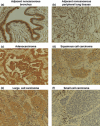Immunohistochemical analysis of CYP2A13 in various types of human lung cancers
- PMID: 20180810
- PMCID: PMC11158637
- DOI: 10.1111/j.1349-7006.2009.01482.x
Immunohistochemical analysis of CYP2A13 in various types of human lung cancers
Abstract
Human CYP2A13, which is expressed in the respiratory tract, is the most efficient enzyme for the metabolic activation of tobacco-specific nitrosamines such as 4-(methylnitrosamino)-1-(3-pyridyl)-1-butanone (NNK). The relevance of CYP2A13 in carcinogenicity and toxicity in the respiratory tract has been suggested, but the expression of CYP2A13 protein in lung cancer tissues remains to be determined. We first prepared a mouse monoclonal antibody against human CYP2A13. The antibody showed no cross reactivity with the other CYP isoforms including CYP2A6. Using the specific antibody, we performed immunohistochemical analysis for human lung carcinomas. In adenocarcinomas (n = 15), all specimens were positive for the staining and five samples showed strong staining. In squamous cell carcinomas (n = 15) and large cell carcinomas (n = 15), each 14 samples were positive for the staining and two and three samples showed strong staining, respectively. In small cell carcinoma samples (n = 15), eight samples were negative for the staining and five samples showed weak or moderate staining. In conclusion, we first found that the expression of CYP2A13 was markedly increased in non-small cell lung carcinomas. The high expression might be associated with the tumor development and progression in non-small cell lung carcinomas.
Figures


Similar articles
-
Substantial reduction in risk of lung adenocarcinoma associated with genetic polymorphism in CYP2A13, the most active cytochrome P450 for the metabolic activation of tobacco-specific carcinogen NNK.Cancer Res. 2003 Nov 15;63(22):8057-61. Cancer Res. 2003. PMID: 14633739
-
CYP2A13: variable expression and role in human lung microsomal metabolic activation of the tobacco-specific carcinogen 4-(methylnitrosamino)-1-(3-pyridyl)-1-butanone.J Pharmacol Exp Ther. 2007 Nov;323(2):570-8. doi: 10.1124/jpet.107.127068. Epub 2007 Aug 1. J Pharmacol Exp Ther. 2007. PMID: 17671098
-
CYP2A13 in human respiratory tissues and lung cancers: an immunohistochemical study with a new peptide-specific antibody.Drug Metab Dispos. 2006 Oct;34(10):1672-6. doi: 10.1124/dmd.106.011049. Epub 2006 Jun 30. Drug Metab Dispos. 2006. PMID: 16815959
-
Human cytochrome P450 CYP2A13: predominant expression in the respiratory tract and its high efficiency metabolic activation of a tobacco-specific carcinogen, 4-(methylnitrosamino)-1-(3-pyridyl)-1-butanone.Cancer Res. 2000 Sep 15;60(18):5074-9. Cancer Res. 2000. PMID: 11016631
-
Pulmonary CYP2A13 levels are associated with early occurrence of lung cancer-Its implication in mutagenesis of non-small cell lung carcinoma.Cancer Epidemiol. 2013 Oct;37(5):653-9. doi: 10.1016/j.canep.2013.04.010. Epub 2013 Jun 7. Cancer Epidemiol. 2013. PMID: 23752126
Cited by
-
Expression of cytochrome P450 2A13 in human non-small cell lung cancer and its clinical significance.J Biomed Res. 2013 May;27(3):202-7. doi: 10.7555/JBR.27.20120019. Epub 2013 Mar 24. J Biomed Res. 2013. PMID: 23720675 Free PMC article.
-
Association between CYP2A13 polymorphisms and lung cancer: A protocol for systematic review and meta-analysis.Medicine (Baltimore). 2020 Dec 11;99(50):e23289. doi: 10.1097/MD.0000000000023289. Medicine (Baltimore). 2020. PMID: 33327254 Free PMC article.
-
HapMap-based study: CYP2A13 may be a potential key metabolic enzyme gene in the carcinogenesis of lung cancer in non-smokers.Thorac Cancer. 2019 Apr;10(4):601-606. doi: 10.1111/1759-7714.12954. Epub 2019 Feb 26. Thorac Cancer. 2019. PMID: 30807688 Free PMC article.
-
Genetic and Enzymatic Characteristics of CYP2A13 in Relation to Lung Damage.Int J Mol Sci. 2021 Nov 14;22(22):12306. doi: 10.3390/ijms222212306. Int J Mol Sci. 2021. PMID: 34830188 Free PMC article. Review.
-
CYP2A13 Acts as the Main Metabolic CYP450s Enzyme for Activating Leonurine in Human Bronchial Epithelial Cells.Med Sci Monit. 2020 Apr 14;26:e922149. doi: 10.12659/MSM.922149. Med Sci Monit. 2020. PMID: 32284524 Free PMC article.
References
-
- Yamano S, Tatsuno J, Gonzalez FJ. The CYP2A3 gene product catalyzes coumarin 7‐hydroxylation in human liver microsomes. Biochemistry 1990; 29: 1322–9. - PubMed
-
- Su T, Bao Z, Zhang QY et al. Human cytochrome P450 CYP2A13: predominant expression in the respiratory tract and its high efficiency metabolic activation of a tobacco‐specific carcinogen, 4‐(methylnitrosamino)‐1‐(3‐pyridyl)‐1‐butanone. Cancer Res 2000; 60: 5074–9. - PubMed
-
- Koskela S, Hakkola J, Hukkanen J et al. Expression of CYP2A genes in human liver and extrahepatic tissues. Biochem Pharmacol 1999; 57: 1407–13. - PubMed
-
- Gu J, Su Y, Chen QY et al. Expression and biotransformation enzymes in human fetal olfactory mucosa: potential roles in developmental toxicity. Toxicol Appl Pharmacol 2000; 165: 158–62. - PubMed
MeSH terms
Substances
LinkOut - more resources
Full Text Sources
Medical

